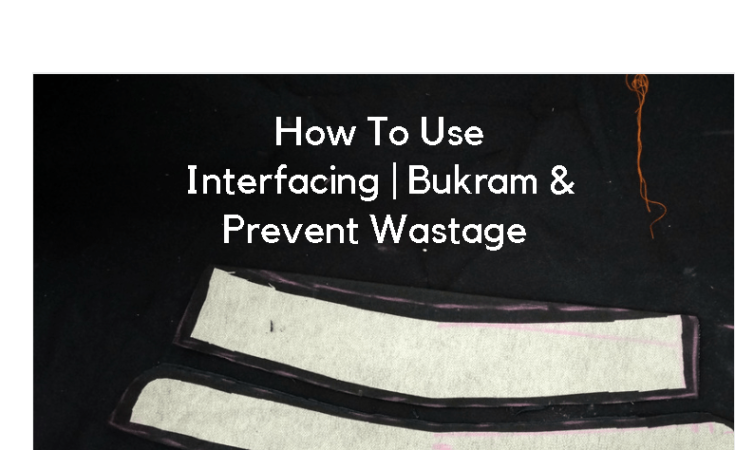You can use bukram or interfacing for getting a crisp and smooth look of a dress.
This facing sheet or canvas is available in your stitching supplies’ store in different thicknesses. Depending on the stiffness you require, you may choose it.
Though, both bukram and fuseable interfacing serve similar purpose and these terms are sometimes used inter changeably but there is some difference in both.
Table of Contents
What is Interfacing
1. Facing is piece of material which we use to give strength to the inside of our dress.
2. Facing is generally used around the neckline for a neat and tidy finishing.
3. For facing, thin stiff fabric or material such as paper pasting is used.
4. These fusings are available in big sheet like form or we can also buy them in different pre-cut, ready-to-use shapes for different purposes.
What is Bukram
1. Buckram is thickened or stiffened coarse cloth, which is used for interfacing.
2. Interfacing is the process when we sandwich this Buckram between two layers of fabric to give a neat finishing to our necklines, collar, cuff etc.
3. With moisture or after wash, buckram gets softer.
4.It not only enhances the look but also increase life of the dress by minimizing wear and tear from the delicate part of a dress.
Many uses of bukram / interfacing
How to Use Bukram or Interfacing
The weight of the interfacing should generally be the same as the fabric, or a bit lighter.
- 1Interfacing comes in different weights - Thick as well as thin - for different purposes. Take a scrap piece of fabric and interfacing. See if the interfacing is suitable and it gives right amount of shaping to the garment. If you find the end result is too “stiff”, you should try a lighter weight interfacing; if the result is too flimsy, try a heavier weight.
- 2Check which side of the interfacing has glue or adhesive on it. The adhesive side normally has a slightly starchy, raised appearance, and you can see a slight shininess.
- 3Cut pattern pieces from the interfacing. If you are using woven interfacing, match up the grain of the interfacing with the grain of the fabric; but you don’t need to worry about this is if you are using non-woven interfacing.
- 4For knit interfacing, match up crosswise stretch with crosswise stretch.
- 5Place the fabric wrong side up on the ironing board. Place the fusible interfacing on top. Adhesive side will face down on to the wrong side of your fabric.
- 6Cover the fabric and interfacing with a damp press cloth, and press the iron on to the fabric.
- 7Keep pressing for about 10-15 seconds at a time, before lifting the iron. Then, move it to the next position, and repeat.
- 8This process will stick the interfacing to the fabric.
- 9When you are assured that interfacing has been glued to the fabric, try and lift a small corner of the interfacing to check it has pasted properly. If not, repeat the pressing process.
- 10If the interfacing has pasted to the fabric, let it cool and dry before moving – the interfacing may be reshaped or distorted if you move it while it’s still warm.
- 11Use “wool” setting for medium or heavy weight fabrics.
- 12For light weight fabrics, use a heat setting slightly higher than that which you would use directly on the fabric.
- 13Check if the temperature setting is appropriate – too hot and you’ll damage your fabric, too cool and the adhesive will not paste to the fabric properly.
- 14Use a press cloth when applying fusible interfacing to protect your fabric from excessive heat.
- 15It is also a good practice to place a layer of scrap fabric under the main fabric.
Sewing Tips to Use Bukram or Interfacing
- 1Generally, white and black color interfacing is used. These are commonly used and available colors. You will get them easily.
- 2When you use lighter shades of fabric, use white buckram for facing. Whereas, when you use darker shades of fabric, use black interfacing.
- 3Facing comes in a wide sheet or you may get it in different cut pieces in the shape of neck, collar etc.
- 4Cut pieces are more expensive if you stitch quite frequently but if you stitch only sometimes they make a better bargain as you don’t need to store them consciously every time you use.
- 5While marking and cutting your facing/canvas, no additional margin required because this facing will go inside the fabric and there will not be any stitching required on it. The seam would be cut 1/4″ or 1/2″ extra around the buckram facing.
- 6Additional margin for stitching and folding will be on upper and lower cloth and not on facing.
How to Save Bukram from Spoilage
Canvas and paper pasting gets a little soggy with moisture if you do not store it properly.
- 1In such a situation, dry your canvas and paper pasting under the Sun for an hour. On ironing, canvas will again be stiff to be used again.
- 2If your facing is with glue on other side, be careful while using iron. The glued side of facing will paste on your ironing table cloth.
- 3Ideally, iron it only when you are using it on your design or on desired fabric.
- 4Paper pasting do not stand direct heat because it’s comparatively very thin. You need to keep a cotton cloth on it to iron. Here also, be careful about the glued side.
- 5While storing your facing, either keep it flat on a surface or roll it up.
- 6Store it out of moist climate conditions in a dry place because it absorbs moisture from the environment.
- 7Steam iron spoils the facing glue. If even a drop of water drips from your steam iron then it will spoil the stickiness of the facing.
- 8If water drips when your steam iron is on, then set the iron on dry mode and keep the heat low







